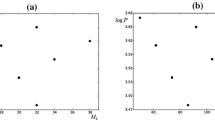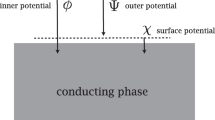Abstract
The theory of one-electron perturbations is developed in the context of the self-consistent LCAO treatment of molecular wavefunctions. A numerical method of calculating changes in the charge and bond order matrix due to one-electron perturbations is described. The method is used to compute self-consistent atom-atom polarizabilities for a number of conjugated hydrocarbons. The results are applied to spin-density calculations and to a discussion of chemical reactivity.
Zesummenfassung
Im Rahmen des SCF-LCAO-Verfahrens wird eine Einteilchen-Störung behandelt and ein numerisches Verfahren zur Berechnung der Änderung der Matrix der Bindungsordnung angegeben. In der vorliegenden Arbeit wird diese Methode benützt, um Atom-Atom-Polarisier-barkeiten und Spindichten für eine Anzahl von Kohlenwasserstoffen zu berechnen sowie ihre chemische Reaktivität zu diskutieren.
Resume
La théorie des perturbations monoélectroniques est developpée au contexte du procédé LCAO autocohérent de fonctions d'ondes moléculaires. On décrit une méthode numérique pour le calcul de changements dans la matrice de charge et d'ordre de liaison dûs aux perturbations monoélectroniques. Suivant cette méthode sont calculées les polarisabilités atome-atome autocohérentes pour un nombre d'hydrocarbures conjugués. A l'aide des résultats on calcule des densités de spin, et discute la réactivités chimiques.
Similar content being viewed by others
References
Carrington, A., F. Dravnieks, andM. C. R. Symons: J. chem. Soc. 947 (1959).
Coulson, C. A., andH. C. Longuet-Higgins: Proc. Roy. Soc.A 191, 39;A 192,16 (1947);A 193, 447 (1948).
Daudel, R., R. Lefebvre, andC. Moser: Quantum chemistry, methods and applications. New York: Wiley (Interscience) 1959.
Greenwood, H. H., andT. H. J. Hayward: Mol. Physics3, 495 (1960).
Hall, G. G.: Philos. Mag.6, 249 (1961).
— Proc. Roy. Soc.A 205, 541 (1951).
—, andA. Hardisson: Proc. Roy. Soc.A 268, 328 (1962).
—, andJ. E. Lennard-Jones: Proc. Roy. Soc.A 202, 155 (1950).
Lefebvre, R., andC. Moser: Calcul des fonctions d'onde moleculaire, p. 109. Paris: Centre National de la Recherche Scientifique 1958.
Löwdin, P.-O.: J. chem. Physics18, 365 (1950).
McConnell, H. M.: J. chem. Physics24, 632, 764 (1956).
McLachlan, A. D.: Mol. Physics3, 233 (1960).
McWeeny, R., andT. E. Peacock: Proc. Phys. Soc.A 70, 41 (1957).
Peng, H. W.: Proc. Roy. Soc.A 178, 499 (1941).
Pople, J. A., andP. Schofield: Proc. Roy. Soc.A 233, 233, 241 (1955).
Roothaan, C. C. J.: Rev. mod. Physics23, 69 (1951).
Snyder, L. C., andA. T. Amos: J. chem. Physics41, 1773 (1964);42, 3670 (1965).
Streitwieser, A., Jr.: Molecular orbital theory for organic chemists New York: Wiley 1961.
Author information
Authors and Affiliations
Rights and permissions
About this article
Cite this article
Amos, A.T., Hall, G.G. Self-consistent perturbation theory for conjugated molecules. Theoret. Chim. Acta 5, 148–158 (1966). https://doi.org/10.1007/BF01138857
Received:
Issue Date:
DOI: https://doi.org/10.1007/BF01138857




